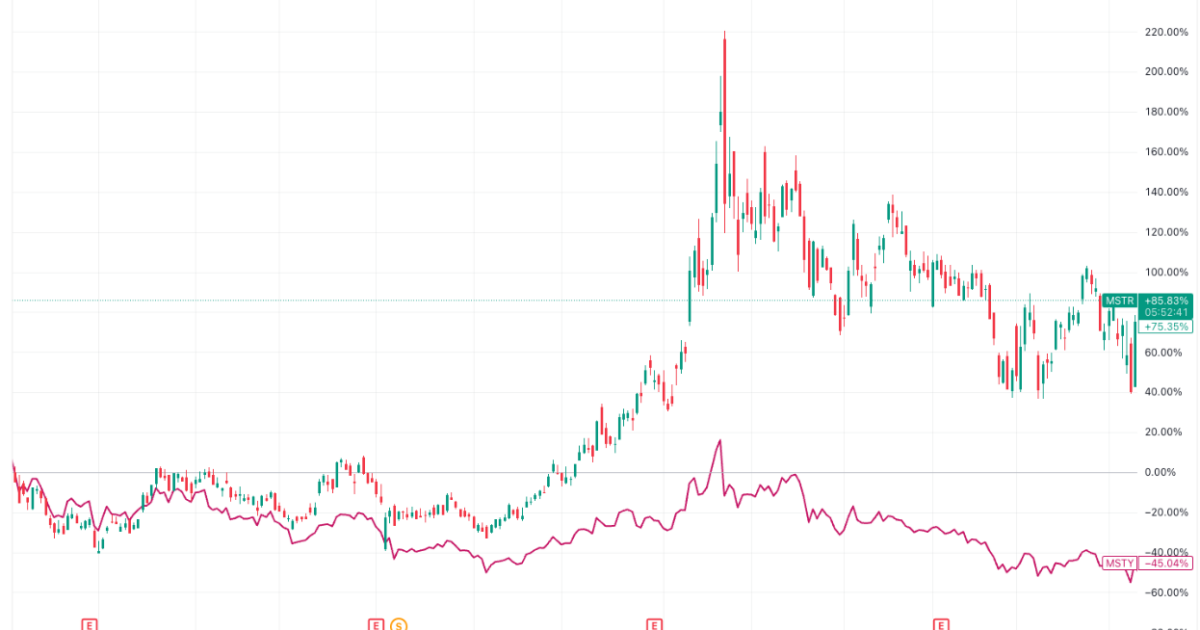Disclaimer: The analyst who wrote this piece owns shares of Strategy (MSTR).
From April 2024 to April 2025, investors in Strategy (MSTR) and the YieldMax MSTR Option Income Strategy ETF (MSTY) followed two distinctly different investment paths — one seeking capital appreciation through bitcoin (BTC) exposure, the other pursuing monthly income via options-based strategies. Both are linked to the performance of MSTR, but their outcomes and structures diverged significantly.
Strategy, listed on the Nasdaq, has evolved from an enterprise software company into a de facto bitcoin proxy. As of April 15, the company holds 531,644 BTC, making its stock highly sensitive to bitcoin’s price movements. Since adopting its bitcoin treasury strategy in August 2020, MSTR shares have surged over 2,500%. However, this growth comes with volatility: Currently, the stock has an implied volatility of 87%, and a 30-day historic volatility of 102%. MSTR is currently 43% below its all-time high set in November 2024, reflecting the sharp swings typical of a bitcoin-correlated asset. The stock pays no dividend.
In contrast, MSTY, launched in April 2024, is an income-focused ETF that does not hold MSTR shares directly. MSTY’s portfolio consists primarily of U.S. Treasury bills, cash, and short-term call options on MSTR, allowing it to synthetically replicate exposure without directly owning the stock.
It employs a synthetic covered call strategy, selling options on MSTR to generate monthly income. This strategy limits upside participation but delivers consistent cash flow, appealing to investors seeking regular distributions.
From April 4, 2024 to April 9, 2025, a $1,000 investment in each product produced the following results:
- MSTR: Fueled by bitcoin’s strong 2024 rally, the investment grew to $1,895, generating a +86% total return.
- MSTY: With 13 monthly distributions totaling $36.53 (ranging from $4.13 in April 2024 to $1.33 in April 2025) reinvested on each ex-dividend date, the investment reached $1,591, a +59% total return.
However, MSTY declined 45% over the year due to its full downside exposure to MSTR’s price movements, without benefiting fully from MSTR’s rallies because of its call-writing strategy. Additionally, consistent high monthly distributions — partly classified as return of capital — reduced the fund’s net asset value over time, further weighing on its share price.
MSTY exhibited significant volatility in its own right, often trading at premiums or discounts to net asset value (NAV), introducing additional price risk.
The premium/discount activity in MSTY reflects both investor demand and underlying volatility in MSTR. Early high volatility supported strong option income and trading premiums, but as volatility eased in 2025, premiums narrowed and discounts appeared more often. However, a renewed bitcoin rally and rising volatility in MSTR could reverse this trend, lifting option income, distributions, and investor demand.
While both products are linked to MSTR’s price action, they serve distinct purposes: MSTR offers high-risk growth potential tied to bitcoin, while MSTY delivers yield through a derivatives-based income strategy with inherent structural limitations.
Unlike traditional income strategies that focus on low-volatility, stable-yield investments like broad index ETFs or dividend stocks. MSTY is geared toward retail investors seeking exceptionally high income — but who are also willing to accept significantly higher risk and volatility.




